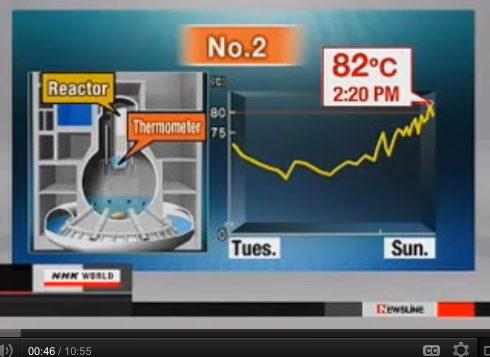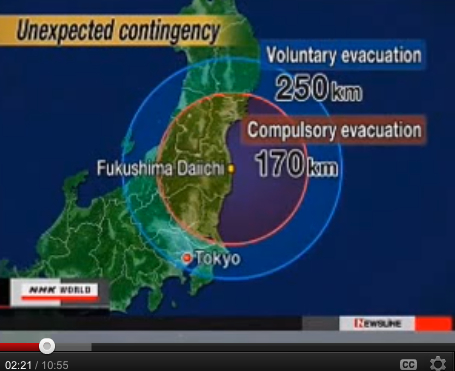It looks like you're using an Ad Blocker.
Please white-list or disable AboveTopSecret.com in your ad-blocking tool.
Thank you.
Some features of ATS will be disabled while you continue to use an ad-blocker.
5
share:
news.yahoo.com...
TOKYO (Reuters) - A scare over temperatures rising near danger level in a reactor at Fukushima Daiichi nuclear plant, where workers are battling to prevent a resurgence of the radiation crisis, could be a false alarm, the plant operator said on Monday. Instruments showed the temperature inside the plant's No.2 reactor topped 90 Celsius on Monday, double what it was a month ago and close to boiling point, in which water cooling nuclear fuel in the reactor could evaporate and start a new meltdown. But a faulty thermometer was likely giving false readings, said Tokyo Electric Power Co, operator of the plant 240 km (150 miles) northeast of Tokyo. The Fukushima plant's cooling system was wrecked by the March 11 earthquake and tsunami, triggering reactor meltdowns and a radiation crisis that has caused widespread contamination and mass evacuations. Tokyo Electric, or Tepco, said it was able to bring the temperature down at two other places in the reactor to about 33C from over 40C a week ago by pumping more water into it. "Following our cooling efforts temperatures at the two other locations are declining steadily while that at the location in question keeps rising. This leads us to think that the thermometer at the location in question is not functioning properly, rather than the actual temperature rising," Junichi Matsumoto, Tepco's general manager, told reporters on Monday. Matsumoto said there was little sign of steam, which would be produced when water is at such a high temperature, and Tepco believes the reactor is still in cold shutdown, meaning temperatures are stable below boiling point. The government announced on December 16 that the plant's reactors had reached a state of cold shutdown, a milestone in cleanup efforts and a pre-condition for allowing about 80,000 residents evacuated from a 20-km (12-mile) radius of the plant to return home. Environment Minister Goshi Hosono said he believed the plant was still in cold shutdown but warned against complacency. "The instruments are showing readings that are difficult to understand but I believe we don't have to change our view that the plant is in cold shutdown," Hosono said in parliament. "Nevertheless we continue to assess the situation ready for all possibilities." Glitches continue to dog Tepco nearly a year after the disaster. Heat is not the only problem the utility and its workers have to battle -- sub zero winter temperatures have frozen many parts of the miles of hastily installed plastic pipes at the plant, creating ruptures and causing the radioactive water they carry to leak. Shattered trust in the safety of nuclear energy has prevented the restart of reactors elsewhere shut for routine maintenance, straining power supply and threatening blackouts. Only three of Japan's 54 nuclear reactors are now operating. Without approval for restarts, all of them could be shut by the end of April, boosting the use of fossil fuels and adding over $30 billion a year to the nation's energy costs, a government estimate said. A visiting team of U.N. nuclear experts has backed stress tests aimed at showing Japan's nuclear plants can withstand the sort of disasters that devastated Fukushima Daiichi. (Reporting by Shinichi Saoshiro; Editing by Michael Watson)
I'd believe in the tooth fairy before I bought into one single story out of TEPCO.
When Japan is glowing in the dark...TEPCO will call it some benign affectation of moonlight glancing off the glow in the dark ocean....:
When Japan is glowing in the dark...TEPCO will call it some benign affectation of moonlight glancing off the glow in the dark ocean....:
thats coming from the same people who said there wasnt a meltdown in the beggining lol even after a couple of exsplosions and obvious damage to
the you know the pics and videos where you can see the green reactor in the rubble , we need to slap the taste out of there mouth
reply to post by Destinyone
Are you implying that the Tooth Fairy is not real? DAMNIT MAN, I NEED ANSWERS!
Interesting about the probable increase in demand for fossil fuel. I'd expect some of these countries to be "liberated" by NATO or the US soon. Look at the number of countries that already have a puppet government or have been destabilized recently. And Russia in second... I don't see that turning out well.
"The instruments are showing readings that are difficult to understand" is TEPCO speak for "hold on to your asses, we're going to get screwed soon." I mean really, if you have what I'm sure are millions of dollars worth of instruments and honestly don't know what's going on you have no business taking care of an ecological disaster. Good thing anyone with the ability to breathe under their own power knows it's bullpoo.
Oh and seriously guys, go buy a thermometer from somewhere other than the ¥1 store.
Are you implying that the Tooth Fairy is not real? DAMNIT MAN, I NEED ANSWERS!
Interesting about the probable increase in demand for fossil fuel. I'd expect some of these countries to be "liberated" by NATO or the US soon. Look at the number of countries that already have a puppet government or have been destabilized recently. And Russia in second... I don't see that turning out well.
"The instruments are showing readings that are difficult to understand" is TEPCO speak for "hold on to your asses, we're going to get screwed soon." I mean really, if you have what I'm sure are millions of dollars worth of instruments and honestly don't know what's going on you have no business taking care of an ecological disaster. Good thing anyone with the ability to breathe under their own power knows it's bullpoo.
Oh and seriously guys, go buy a thermometer from somewhere other than the ¥1 store.
Fukushima Temp rises Highest Yet! Evacuate Tokyo? update 2/12/12
www.youtube.com...
This sounds pretty serious
www.youtube.com...
This sounds pretty serious
reply to post by omegacorps
Okay, which bucket of Tepco lies do you want me to dribble into the ocean first?
"Operator of the plant" lol, I didn't know that Fukushima plants were still operating, did you?
"But sir, they are but faulty like falsely opening their mouths."
"I don't care. Make it sound good. That is all."
But a faulty thermometer was likely giving false readings, said Tokyo Electric Power Co, operator of the plant 240 km (150 miles) northeast of Tokyo.
Okay, which bucket of Tepco lies do you want me to dribble into the ocean first?
"Operator of the plant" lol, I didn't know that Fukushima plants were still operating, did you?
"But sir, they are but faulty like falsely opening their mouths."
"I don't care. Make it sound good. That is all."
reply to post by intrptr
yeah like they have the best media spin merchants that money can buy and the best they can come up with is faulty thermometers thats money well spent
yeah like they have the best media spin merchants that money can buy and the best they can come up with is faulty thermometers thats money well spent
reply to post by Bilder
I wonder how much the going rate is for Karl Rove and Dick Cheney... Apparently it's less than actually doing something about it.
I wonder how much the going rate is for Karl Rove and Dick Cheney... Apparently it's less than actually doing something about it.
Originally posted by Bilder
Fukushima Temp rises Highest Yet! Evacuate Tokyo? update 2/12/12
www.youtube.com...
This sounds pretty serious
Hey Bilder , Stop that! (Your Avatar)
Just a couple of snapshots from the video you brought...
This one shows the location of the "suspect" thermometer in orange:

They call it a thermometer, but really it is a "thermocouple", a bi metal resistance coefficient device that if it was "faulty" would not display a temp. at all. If it is showing a temp. then that is accurate. And it is located right where we would expect the temp rise to be detected. Just above their tiny graphic of the "little turd of melt" at the bottom of RPV. How dumb do we think we are, Tepco?
Next we have the ever-expanding bubble to include the (so far) voluntary evacuation of the worlds largest city:

Hey... what are you guys going to do when the "slow rad shockwave bubble" expands to cover all of Japan?
Thanks for bringing the You Tube video. It is worth a view all.
reply to post by intrptr
yeah one would think that would have been the first thing damaged in week one.
but here we sit.
if my car over heats the first G** D*** thing i check is the thermostat
put some " good ole boys " over there with a keg and some duct tape. we would have been in cold shut down a while ago.
yeah one would think that would have been the first thing damaged in week one.
but here we sit.
if my car over heats the first G** D*** thing i check is the thermostat
put some " good ole boys " over there with a keg and some duct tape. we would have been in cold shut down a while ago.
new topics
-
Ed Dowd some good news
Medical Issues & Conspiracies: 2 hours ago -
Anyone like the Scorpions?
Music: 2 hours ago -
What if this is true?
2024 Elections: 3 hours ago -
Merry-Go-Round Ride
Short Stories: 5 hours ago -
It's toast
General Chit Chat: 9 hours ago -
Man Stabbed or Cardiac arrest on Westminster Bridge, London, UK
Mainstream News: 11 hours ago
top topics
-
Petition Calling for General Election at 564,016 and rising Fast
Political Issues: 15 hours ago, 14 flags -
A fix for the Trans players in sports
Social Issues and Civil Unrest: 12 hours ago, 14 flags -
What if this is true?
2024 Elections: 3 hours ago, 10 flags -
Man Stabbed or Cardiac arrest on Westminster Bridge, London, UK
Mainstream News: 11 hours ago, 7 flags -
It's toast
General Chit Chat: 9 hours ago, 7 flags -
Merry-Go-Round Ride
Short Stories: 5 hours ago, 5 flags -
Ed Dowd some good news
Medical Issues & Conspiracies: 2 hours ago, 4 flags -
Anyone like the Scorpions?
Music: 2 hours ago, 3 flags
active topics
-
What if this is true?
2024 Elections • 21 • : AlexandrosOMegas -
A fix for the Trans players in sports
Social Issues and Civil Unrest • 19 • : Macenroe1982 -
France gives Ukraine license to fire long-range missiles at Russia
World War Three • 40 • : cherokeetroy -
Ed Dowd some good news
Medical Issues & Conspiracies • 2 • : annonentity -
Results of the use of the Oreshnik missile system in Dnepropetrovsk
World War Three • 218 • : Imhere -
Anyone like the Scorpions?
Music • 2 • : Flyingclaydisk -
Merry-Go-Round Ride
Short Stories • 5 • : randomuser2034 -
Russia Ukraine Update Thread - part 3
World War Three • 6876 • : worldstarcountry -
Petition Calling for General Election at 564,016 and rising Fast
Political Issues • 65 • : Oldcarpy2 -
It's toast
General Chit Chat • 9 • : Bluntone22
5
